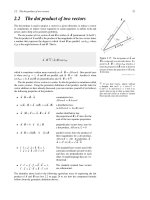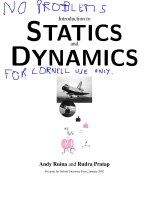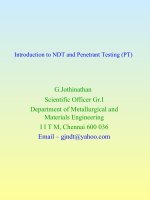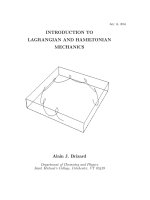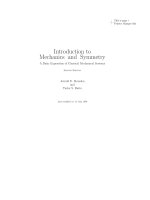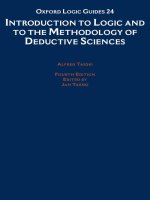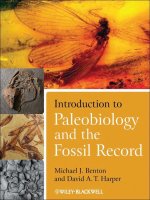- Trang chủ >>
- Khoa Học Tự Nhiên >>
- Vật lý
the oxford introduction to proto-indo-european and the proto-indo-european world nov 2006
Bạn đang xem bản rút gọn của tài liệu. Xem và tải ngay bản đầy đủ của tài liệu tại đây (10.96 MB, 760 trang )
The Oxford Introduction to Proto-Indo-European and the
Proto-Indo-European World
This page intentionally left blank
The Oxford Introduction to
Proto-Indo-European and the
Proto-Indo-European World
J. P. Mallory and
D. Q. Adams
1
1
Great Clarendon Street, Oxford ox26dp
Oxford University Press is a department of the University of Oxford.
It furthers the University’s objective of excellence in research, scholarship,
and education by publishing worldwide in
Oxford New York
Auckland Cape Town Dar es Salaam Hong Kong Karachi
Kuala Lumpur Madrid Melbourne Mexico City Nairobi
New Delhi Shanghai Taipei Toronto
With oYces in
Argentina Austria Brazil Chile Czech Republic France Greece
Guatemala Hungary Italy Japan Poland Portugal Singapore
South Korea Switzerland Thailand Turkey Ukraine Vietnam
Oxford is a registered trade mark of Oxford University Press
in the UK and in certain other countries
Published in the United States
by Oxford University Press Inc., New York
ß J. P. Mallory and D. Q. Adams 2006
The moral rights of the authors have been asserted
Database right Oxford University Press (maker)
First published 2006
All rights reserved. No part of this publication may be reproduced,
stored in a retrieval system, or transmitted, in any form or by any means,
without the prior permission in writing of Oxford University Press,
or as expressly permitted by law, or under terms agreed with the appropriate
reprographics rights organization. Enquiries concerning reproduction
outside the scope of the above should be sent to the Rights Department,
Oxford University Press, at the address above
You must not circulate this book in any other binding or cover
and you must impose the same condition on any acquirer
British Library Cataloguing in Publication Data
Data available
Library of Congress Cataloguing in Publication Data
Data available
Typeset by SPI Publisher Services, Pondicherry, India
Printed in Great Britain
on acid-free paper by
Biddles Ltd., www.biddles.co.uk
ISBN 0-19-928791-0 978-0-19-928791-8 (HB)
0-19-929668-5 978-0-19-929668-2
13579108642
Contents
List of Maps xii
Lits of Figures xiii
List of Tables xiv
List of Abbreviations and Acronyms xix
Introduction xxii
1 Discovery 1
1.1 Language relations 1
1.2 Indo-European 6
2 The Elements 12
2.1 The Indo-European languages 12
2.2 Celtic 15
2.3 Italic 18
2.4 Germanic 19
2.5 Baltic 23
2.6 Slavic 25
2.7 Albanian 26
2.8 Greek 27
2.9 Anatolian 28
2.10 Armenian 31
2.11 Indo-Aryan 32
2.12 Iranian 33
2.13 Tocharian 35
2.14 Minor languages 36
3 Reconstructing Proto-Indo-European 39
3.1 The Comparative Method 39
3.2 Schleicher’s Tale 45
3.3 Laryngeal Theory 48
3.4 Reconstruction and Reality 50
4 The System 54
4.0 The System 54
4.1 Phonology 54
4.2 The Noun 56
4.3 Adjectives 59
4.4 Pronouns 59
4.5 Numerals 61
4.6 Particles and Conjunctions 62
4.7 Prepositions 62
4.8 Verbs 62
4.9 Derivation 65
5 Relationships 71
5.0 Linguistic Relationship 71
5.1 Internal Relationships 71
5.2 External Relations 81
5.3 Genetic Models 83
6 A Place in Time 86
6.0 The Fourth Dimension 86
6.1 Time Depth 86
6.2 Relative Chronologies 88
6.3 Absolute Chronologies 92
6.4 The Dark Ages? 103
7 Reconstructing the Proto-Indo-Europeans 106
7.1 Approaches to the Past 106
7.2 How Many Cognate s? 107
7.3 Reconstructed Meaning 110
7.4 Semantic Fields 112
7.5 Folk Taxonomies 113
7.6 Level of Reconstruction 115
7.7 Root Homonyms 115
7.8 How Long a Text? 116
7.9 Vocabulary—What’s Missing? 117
8 The Physical World 120
8.1 Earth 120
8.2 Fire 122
8.3 Water 125
vi contents
8.4 Air 128
8.5 The Physical Landscape of th e
Proto-Indo-Europeans 130
9 Indo-European Fauna 132
9.1 Reconstructing Environments 132
9.2 Mammals 134
9.3 Birds 143
9.4 Fish, Reptiles, Amphibians 146
9.5 Insects, Shellfish, etc. 148
9.6 Indo-European Animals 151
10 Indo-European Flora 156
10.1 Trees 156
10.2 Wild Plants 161
10.3 Domesticated Plants 163
10.4 Agricultural Terms 167
10.5 Proto-Indo-European Flora 169
11 Anatomy 173
11.0 The Body 173
11.1 The Head 173
11.2 Hair 176
11.3 The Upper Body and Arms 178
11.4 The Lower Body and Legs 182
11.5 Internal Organs 185
11.6 Vital Functions 188
11.7 Health and Disease 192
11.8 The Lexicon of the Body 199
12 Family and Kinship 203
12.1 Family and Household 203
12.2 Marriage 206
12.3 Kinship 209
13 Hearth and Home 219
13.1 Dwelling 219
13.2 Construction 223
13.3 Proto-Indo-European Settlement 227
CONTENTS vii
14 Clothing and Textiles 230
14.1 Textiles 230
14.2 Proto-Indo-European Textile Production 236
15 Material Culture 239
15.1 Containers 239
15.2 Metals 241
15.3 Tools 242
15.4 Weapons 244
15.5 Ornament 246
15.6 Transport 247
15.7 Roads 250
15.8 Proto-Indo-European Material Culture 251
16 Food and Drink 254
16.1 Eat and Drink 254
16.2 Preparation 258
16.3 Foods and Meals 260
16.4 Proto-Indo-European Diet 264
17 Proto-Indo-European Society 266
17.1 Social Organization 266
17.2 Give and Take 270
17.3 Exchange and Property 272
17.4 Law and Order 276
17.5 Strife and Warfare 277
17.6 Occupations 283
17.7 Proto-Indo-European Society 284
18 Space and Time 287
18.1 Space 287
18.2 Position 288
18.3 Direction 293
18.4 Placement (Verbs) 295
18.5 Shape 297
18.6 Time 300
18.7 Proto-Indo-European Space and Time 303
19 Number and Quantity 307
19.0 Numerical Systems 307
viii contents
19.1 Basic Numerals 308
19.2 Measure and Quantity 317
20 Mind, Emotions and Sense Perception 321
20.1 Knowledge and Thought 321
20.2 Sight 325
20.3 Bright and Dark 328
20.4 Colours 331
20.5 Hearing, Smell, Touch and Taste 334
20.6 The Good, Bad and the Ugly 336
20.7 Desire 340
20.8 Love and Hate 342
20.9 Hot, Cold and other Qualities 344
20.10 Proto-Indo-European Perception 348
21 Speech and Sound 352
21.0 Speech and Sounds 352
21.1 Speech 352
21.2 Elevated Speech 355
21.3 Interjections and Human Sounds 359
21.4 Animal Sounds 363
21.5 Proto-Indo-European Speech 365
22 Activities 368
22.1 Existence, Ability and Attempt 368
22.2 Reductive Activities 371
22.3 Rotary and Lateral Activities 377
22.4 Bind, Stick and Smear 380
22.5 Bend and Press 382
22.6 Inflation 385
22.7 Extend 387
22.8 Throw 388
22.9 Clean 389
22.10 Movement 390
22.11 Pour and Flow 393
22.12 Come and Go 394
22.13 Run and Jump 397
22.14 Crawl, Slide and Fall 400
22.15 Travel 401
CONTENTS ix
22.16 Swim 403
22.17 Convey 404
23 Religion 408
23.1 Deities 408
23.2 The Sacred 411
24 Grammatical Elements 415
24.0 Pronouns 415
24.1 Personal and Reflexive Pronouns 415
24.2 Demonstrative Pronouns 417
24.3 Interrogative Pronouns 419
24.4 Relative Pronouns 421
24.5 Conjunctions 421
25 Comparative Mythology 423
25.0 Reconstructing Mythologies 423
25.1 Approaches to Mythology 427
25.2 Deities 431
25.3 Creation 435
25.4 War of the Foundation 436
25.5 Hero and Serpent 436
25.6 Horse Sacrifice 437
25.7 King and Virgin 437
25.8 Fire in Water 438
25.9 Functional Patterns 438
25.10 Death and th e Otherworld 439
25.11 Final Battle 439
25.12 Current Trends 440
26 Origins—The Never-Ending Story 442
26.1 The Homeland Problem 442
26.2 Homeland Approaches 444
26.3 What Does the Homeland Look Like? 453
26.4 Evaluating Homeland Theories 454
26.5 Processes of Expansion 458
26.6 Where Do They Put It Now? 460
x contents
Appendices
Appendix 1 Basic Sound Correspondences between PIE and the Major IE
Groups 464
Appendix 2 A Proto-Indo-European–English Word-list 466
Appendix 3 An English–Proto-Indo-European Word-list 523
References 565
Index of Languages 591
Index of Subjects and Places 619
CONTENTS xi
List of Maps
1.1. Map of the Indo-European world 8
1.2. Surviving Indo-European groups 9
1.3. Major known non-Indo-European groups in
Europe and western Asia 10
2.1. Distribution of the Celtic languages 17
2.2. Distribution of the Italic languages 20
2.3. Distribution of the Germanic languages 21
2.4. Distribution of the Baltic and Slavic languages 24
2.5. Distribution of the Anatolian and Phrygian languages 29
2.6. Distribution of the Indo-Aryan and Iranian languages 32
26.1. The Indo-European homeland problem 461
List of Figures
5.1. Schleicher’s family tree of the Indo-European
languages 72
5.2. A ‘wave model’ of some of the interrelationships of the
Indo-European languages 73
5.3. A modern tree diagram of the Indo-European
languages suggested by Eric Hamp (1990) 74
5.4. A recent family tree of the Indo-European
languages prepared by D. Ringe, T. Warnow
and A. Taylor (1995) 80
5.5. The Nostratic languages according to A. Bomhard (1996) 84
7.1. The levels of Indo-European reconstruction 111
12.1. Reconstructed PIE kinship terms for blood relatives 217
12.2. Reconstructed PIE in-law terminology (for the husband) 217
12.3. Reconstructed PIE in-law terminology (for the wife) 218
List of Tables
1.1. Some common words in English, Dutch, Czech and Spanish 2
1.2. Comparable words in Old English, Old Norse and Latin 3
1.3. Scaliger’s language groups based on their word for ‘god’ 4
1.4. Comparable words in the classical languages and Sanskrit 5
1.5. The verb ‘to carry’ in Sanskrit, Greek and Latin 6
1.6. Status of Indo-European groups 9
2.1. Major and minor groups of Indo-European languages 13
2.2. Antiquity of earliest attestation (in units of 500 years)
of each Indo-European group 14
2.3. Language group citation frequency in two
Indo-European encyclopedias 15
2.4. The evidence of Celtic 16
2.5. Continental Celtic and some Old Irish equivalents 18
2.6. The evidence of the Italic languages 19
2.7. Some IE cognates from the main Italic languages 21
2.8. The evidence of the Germanic languages 22
2.9. Some basic comparisons between the major
early Germanic languages 23
2.10. The evidence of the Baltic languages 23
2.11. Some cognate words in the Baltic languages 25
2.12. The evidence of the Slavic languages 26
2.13. A comparison of some cognate terms in Old
Church Slavonic and Russian with Lithuanian,
a Baltic language 27
2.14. The basic Albanian numerals are cognate with
other IE nu mbers 27
2.15. Linear B and Classical Greek 28
2.16. The evidence of the Greek language 28
2.17. The evidence of the Anatolian languages 30
2.18. Selected cognate words in Hittite, Old English and
New English 30
2.19. Selected cognates in Armenian, Old English and
New English 31
2.20. Selected cognates in Sanskrit and Avestan 34
2.21. Selected cognates in Tocharian, Old English and
New English 35
3.1. The Sanskrit alphabet 40
3.2. Comparison of three Indo-European words 41
3.3. Selected sound correspondences across the
Indo-European languages 41
3.4. The singular endings of the verb ‘carry’ in Indo-European 45
3.5. Short vowel ablaut patterns in Greek 48
3.6. Long vowel ablaut patterns in Greek 49
3.7. The Proto-Indo-European consonant system 51
3.8. Normal marking of labials 51
3.9. Proto-Indo-European labials 52
3.10. The labials in the glottalic system 52
3.11. The labials in Wu 53
3.12. The traditional Proto-Indo-European system and its glottalic
equivalents 53
4.1. The Proto-Indo-European phonological system 55
4.2. Common Indo-European suYxes 57
4.3. Basic case endings of the Indo-European noun 57
4.4. Accent shift in case forms 58
4.5. Endings of o-stem nouns 58
4.6. h
2
-(or a
¯
)-stem endings 59
4.7. Personal pronouns 60
4.8. Some basic numerals 61
4.9. Proto-Indo-European personal endings 64
4.10. The verb *h
1
e
´
s- ‘to be’ in the present active indicative 64
4.11. Second conjugation of *bher- ‘to carry’ in the
present active indicative 65
4.12. Nominal and verbal derivatives of *steh
2
- ‘stand’ 66
4.13. Derivational tree of *h
2
eh
x
- ‘be hot, burn’
(cf. Palaic ha
¯
- ‘be hot). 67
4.14. Illustration of Indo-European ablaut in derivation
(PIE *sed- ‘sit’ and *pet- ‘Xy’) 68
4.15. Schleicher’s Tale 69
5.1. Yas
ˇ
t 10.6 from the Avesta and a Sanskrit translation 76
5.2. Pronouns in Proto-Ind o-European, Proto-Uralic
and Proto-Afro-Asiatic 83
LIST OF TABLES xv
6.1. Indo-European words for ‘Wre’ 91
6.2. Dates of separation from Proto-Indo-European
based on the 100 and 200 word lists (after Tischler 1973) 95
6.3. The ‘‘basic’’ vocabulary of Proto-Indo-European
and its attestation in the major Indo-European groups 97
7.1. Cognates that are found in all major
Indo-European groups 108
7.2. Number of cognate sets attested per number
of groups sharing a cognate 108
7.3. Cognates of *h
2
o
´
wis 112
7.4. Cognates of *bheh
a
go
´
s 112
7.5. Cognates of *m(e)uh
x
- 113
7.6. Cognates of *k
(w)
r
˚
wis 113
7.7. Verbs concerned with speaking in Proto-Indo-European 114
7.8. Some PIE ‘‘homonyms’’ 116
7.9. Some examples of poetic diction built on *k
ˆ
le
´
wos ‘fame’ 118
8.1. Earth 121
8.2. Fire 123
8.3. Water 125
8.4. Air 128
9.1. Mammals 134
9.2. Birds 143
9.3. Fish, reptiles, amphibians 146
9.4. Insects, shellWsh, etc. 149
9.5. Animal names in Proto-Indo-European and Uralic 151
10.1. Trees 157
10.2. Plants (non-domesticated) 162
10.3. Domesticated plants 164
10.4. Agricultural terminology 167
11.1. The head 174
11.2. Hair 177
11.3. The upper body and arms 179
11.4. The lower body and legs 183
11.5. Internal organs 185
11.6. Vital functions 189
11.7. Health and sickness 193
xvi list of tables
11.8. Frequency of occurrence of body part names
in American English and the number of cognate
groups in Proto-Indo-European 200
12.1. Family and household 204
12.2. Marriage 207
12.3. Kinship 209
13.1. Terms for dwelling 220
13.2. Construction and furnishing 224
14.1. Textile terms 231
15.1. Containers 240
15.2. Metals 241
15.3. Tools 242
15.4. Weapons 245
15.5. Transport 247
15.6. Roads 250
16.1. Hunger, eating and drinking 255
16.2. Food preparation 258
16.3. Foods 260
17.1. Society and social organization 267
17.2. Give and take 270
17.3. Exchange and property 273
17.4. Law and order 276
17.5. Strife and warfare 278
17.6. Occupations 283
18.1. Space 288
18.2. Position 289
18.3. Direction 294
18.4. Placement (verbs) 295
18.5. Shape 298
18.6. Time 300
19.1. Basic numbers 308
19.2. Measure and quantity 317
20.1. Knowledge and thought 322
20.2. Sight 325
20.3. Bright and dark 328
20.4. Colours 331
20.5. Hearing, smell, touch and taste 335
20.6A. Positive qualities 336
LIST OF TABLES xvii
20.6B. Negative qualities 338
20.7. Desire 341
20.8. Love and hate 343
20.9. Qualities 345
21.1. Speech 353
21.2. Elevated speech and song 356
21.3. Human noises 360
21.4. Animal sounds 363
22.1. Existence, doing and making 369
22.2. The verb ‘to be’ in selected IE languages 369
22.3. Reductive activities 372
22.4. Rotary and lateral activities 378
22.5. Binding 381
22.6. Bend and press 383
22.7. InXation 385
22.8. Extend 387
22.9. Throw 389
22.10. Clean 390
22.11. Movement 391
22.12. Pour and Xow 393
22.13. Come and go 395
22.14. Run and jump 398
22.15. Crawl, slide and fall 400
22.16. Travel 402
22.17. Swim 403
22.18. Convey 405
23.1. Deities and mythical personages 409
23.2. The sacred and sacriWce 412
24.1. Personal and reXexive pronouns 416
24.2. Demonstrative pronouns 418
24.3. Interrogative pronouns 419
24.4. Relative pronouns 421
24.5. Conjunctions 422
25.1. The three heaven s of the Indo-Europeans after J. Haudry 428
25.2. Indo-European social classes 429
xviii list of tables
List of Abbreviations and Acronyms
(All dates are approximate)
Alb ¼ Albanian (16th century onwards).
Arm ¼ Armenian (5th century onwards).
Av ¼ Avestan, Iranian (1st millennium bc).
Bakhtiari ¼ a Southwest Iranian language (modern).
Bret ¼ Breton, Celtic (6th century ad onwards).
Bulg ¼ Bulgarian, a south Slavic language (11th century onwards).
Corn ¼ Cornish, Celtic language of Cornwall.
Cretan Grk ¼ the variety of ancient Greek spoken on Crete.
Czech ¼ Czech, a western Slavic language (11th century onwards).
Doric Grk ¼ Doric Greek, one of the principal groups of the West Greek
dialects.
Gallo-Roman ¼ the Latin spoken in Gaul after the Roman conquest.
Gaul ¼ Gaulish, a Continental Celtic language (3rd–1st centuries bc).
Goth ¼ Gothic, an eastern Germanic language (4th century ad).
Grk ¼ Greek (8th century bc onwards).
HierLuv ¼ Hieroglyphic Luvian, an Anatolian language (1300–700 bc).
Hit ¼ Hittite, an Anatolian language (1650–1190 bc).
Homeric Grk ¼ the Greek dialect of the Homeric poems (800 bc).
Ibero-Celtic ¼ the variety of Celtic spoken in Iberia (3rd–1st centuries bc).
Illyr ¼ Illyrian.
Ishkashmi ¼ a Southeast Iranian language (modern).
Kashmiri ¼ Indic language of Kashmir (14th century onwards).
Khot ¼ Khotanese, an Eastern Iranian language (5th–10th centuries ad).
Khowar ¼ Dardic/Northwestern Indic language (modern).
KhuW ¼ a Southeast Iranian language (modern).
Kurd ¼ Kurdish, a North-west Iranian language (modern).
Lat ¼ Latin (7th centur y bc onwards).
Latv ¼ Latvian, Baltic (16th century onwards).
Ligurian ¼ presumably Celtic language of north Italy.
Lith ¼ Lithuanian, Baltic (18th century onwards).
Luv ¼ Luvian, Anatolian language (17th–8t h centuries bc).
Lyc ¼ Lycian, Anatolian language of southwest Anatolia (6th–4th centur-
ies bc).
Lyd ¼ Lydian, Anatolian language of west central Anatolia (6th– 4th
centuries bc).
Maced ¼ Macedonian, a language closely related to Greek.
MDutch ¼ West (Low) Germanic (c 1300 to 1500).
ME ¼ Middle English, Germanic (12th–15th centuries).
Messapic – non-Italic language of southeast Italy (6th–1st centuries bc).
MHG ¼ Middle High German (ad 1050–1500).
MIr ¼ Middle Irish, Celtic (ad 900–1200).
Mitanni ¼ Hurrian (non-IE) language of the upper Euphrates with elem-
ents of Indo-Aryan (15th–14th centuries bc).
MLG ¼ Middle Low German (ad 1050–1350).
MPers ¼ Middle Persian, Southwestern Iranian (200 bc–ad 700).
MWels ¼ Middle Welsh, Celtic (ad 1200–1500).
Myc ¼ Mycenaean, earliest attested Greek (16th? –13th centuries bc).
NDutch ¼ modern Dutch, West Germanic (1500 onwards).
NE ¼ New (Modern) English, Germanic (1500 onwards).
NHG ¼ New High German, Germanic (1500 onwards).
NIce ¼ New Icelandic, North Germanic language (1400 onwards).
NIr ¼ New Irish, Celtic (1200 onwards).
Norw ¼ Norwegian, North Germanic (1800 onwards).
NPers ¼ New Persian, Southwestern Iranian (8th century ad onwards).
OBrit ¼ Old British, Celtic (until 8th century ad).
OCS ¼ Old Church Slavonic, Slavic (9th–13th centuries).
OCzech ¼ Old Czech, West Slavic (13th–16th centuries).
OE ¼ Old English, Germanic (800–1150).
OHG ¼ Old High German, West Germanic (750 to 1050).
OIr ¼ Old Irish, Celtic (600 to 900).
OLat ¼ Old Latin (6th–2nd centuries bc).
OLith ¼ Old Lithuanian, Baltic (16th–18th centuries).
ON ¼ Old Norse, Germanic (1150–1550).
OPers ¼ Old Persian, Southwestern Iranian (6th–5th centu ries bc).
OPol ¼ Old Polish, West Slavic (13th–15th centuries).
OPrus ¼ Old Prussian, West Baltic (16th–18th centuries).
ORus ¼ Old Russian, East Slavic (1050–1600).
Osc ¼ Oscan, Italic (5th–1st centuries bc).
Oss ¼ Ossetic, Northeast Iranian (modern).
xx list of abbreviations and acronyms
OSwed ¼ Old Swedish, North Germanic language (13th–14th centuries).
OWels ¼ Old Welsh, Celtic (9th–12th centuries).
Pal ¼ Pa laic, Anatolian (c. 16th century bc).
Parth ¼ Parthian, Northwest Iranian (3rd–1st centuries bc).
Pashto ¼ Southeast Iranian (modern).
Phryg ¼ Phrygian (8th–3rd centuries bc and 1st centur y ad).
PIE ¼ Proto-Indo-European.
Pol ¼ Polish, Western Slavic (13th century onwards).
Roshani ¼ Southeast Iranian (modern).
Runic ¼ language of the earliest Germanic inscriptions (3rd–6th
centuries ad).
Rus ¼ Russian, East Slavic (c. 1050 ad onwards).
RusCS ¼ Russian variety of Old Church Slavonic.
Sanglechi ¼ Southeast Iranian (modern).
Sarikoli ¼ Southeast Iranian (modern).
SC ¼ Serbo-Croatian, South Slavic (19th century onwards).
SGael ¼ Scots Gaelic, Celtic (13th century onwards).
Scyth ¼ Scythian, Iranian.
SerbCS ¼ Serbian variety of Old Church Slavonic.
Shughni ¼ Southeast Iranian (modern).
Skt ¼ Sanskrit, Indo-Aryan (1000 bc onwards)
Slov ¼ Slovene, South Slavic (16th century onwards).
Sogdian ¼ Northeast Iranian (4th–8th centuries).
Swed ¼ Swedish, North Germanic (15th century onwards).
Thessalian Grk ¼ classical Greek dialect of Thessaly.
Thrac ¼ Thracian (5th century bc).
TochA ¼ Tocharian A (7th–10th centuries ad).
TochB ¼ Tocharian B (5th–13th centuries ad).
Umb ¼ Umbrian, Italic (3rd–1st centuries bc).
Waigali ¼ Nu¯rista
¯
ni, Indo-Iranian (modern).
NWels ¼ New Welsh, Celtic (1500 onwards).
LIST OF ABBREVIATIONS AND ACRONYMS xxi
This page intentionally left blank
Introduction
The Oxford Introduction to Proto-Indo-European and The Proto-Indo -Euro-
pean World Wlls the need for a relatively concise introduction to the full
range of reconstructed vocabulary of the language that gave rise to
the world’s largest language family. It addresses two levels of readers. The
Wrst comp rises general readers and students who want to know more about
the Indo-Europeans and how they spoke, as well as professionals in discip-
lines such as archaeology who need to deal with the early Indo-Europeans.
The second consists of linguists interested in reWning, challenging, or adding
to our understanding of Proto-I ndo-European.
The book is broadly divided into two parts. The Wrst, aimed principally
at the Wrst group of readers, gives concise introductions to: the discovery
and composition of the Indo-European language family (chapters 1 and 2);
the way the proto-language has been reconstructed (chapter 3); its most
basic grammar (chap ter 4); the interrelationships between the diVerent
language groups (chapter 5); and the temporal position of the Indo-
European languages (chapter 6). Some of the diYculties involved in recon-
structing a proto-language are described in chapter 7.
The second part, aimed at all readers, provides accounts by semantic
Weld of the Proto-Indo-European lexicon. Where the evidence suggests that
an item may be reconstructed to full Proto-Indo-European antiquity, we
provide a summary table giving the reconstructed form, its meaning, and
its cognates in English and in the three ‘classical’ languages of Latin,
Greek, and Sanskrit. Our survey of semantic Welds travels Wrst into the
natural world of the earth and heavens, fauna, and Xora, before moving
into the human realms of anatomy, kinship, architecture, clothing, material
culture, food and drink, and social organization. It then looks at the more
abstract notions of space, time and quantity, before turning to consider-
ations of mind, perception, speech, activity, and Wnally religion. This
organization reXects Carl Darling Buck’s in his A Dictionary of Selected
Synonyms in the Principal Indo-European Languages, and we have indeed
aimed to do for Proto-Indo-European something of what Buck did for the
individual Indo-European languages.
The Wnal three chapters describe some of the commonest grammatical
elements of Proto-Indo-European, survey the methods used to recon-
struct the mythology of the Proto-Indo-Europeans, and examine the
various attempts at locating the Proto-Indo-European homeland. In
addition to standard indexes, the book also contains two word lists: a
Proto-Indo-European English list and a list of the Proto-Indo-European
vocabulary arranged by its English meaning (which should at least facili-
tate those who delight in such tasks as translating Hamlet into Klingon).
Students and general readers will be able to gain a broad knowledge
from this bo ok of the ancient language that underlies all the modern Indo-
European languages. We hope that the arrangement of evidence by semantic
group here will also stimulate research by linguists. One cannot be con-
fronted with a list of, say, verbal roots all with the same ‘reconstructed’
meaning without wondering how their semantic valence may have diVered in
the proto-language and to what extent it might be possible to recover
something of their earlier nuances. Altho ugh we frequently allude to at-
tempts to discuss the data according to some system of folk taxo nomy, this is
obviously another area that has been insuYciently examined in the study of
Proto-Indo-European. The various regional ascr iptions of cognates will
doubtless be subject to further scrutiny: the discovery of an Iranian cognate,
say, to a word otherwise only found in European languages would change
our conception of Proto-Indo-European itself. Other areas for further in-
vestigation include quantitative approaches to the Indo-European vocabu-
lary (for example, phoneme preferences and investigation of sound
symbolism by semantic class), and the comp arison of Proto- Indo-European
with other reconstructed proto-languages.
The Proto-Indo-Eur opean Weld of study opens a window on a distant
past and presents the scholar and student with many opportunities
for investigation and discovery. We hope the present guide will reveal
something of its vibrancy, challenge, and endless fascin ation.
xxiv introduction
